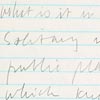 Generation Gap: Paul Horgan (1903–1994). As he observed the "self-flesh and self-sex absorption" of hippie culture in the late 1960s, novelist Paul Horgan confronted his own advancing age.
Generation Gap: Paul Horgan (1903–1994). As he observed the "self-flesh and self-sex absorption" of hippie culture in the late 1960s, novelist Paul Horgan confronted his own advancing age.
About the Diary
The so-called Summer of Love brought what Hunter Thompson called "freaks, heads, fun-hogs and weird night-people of every description" to Aspen, Colorado, in 1967 for "a wild and incredible dope orgy." The following summer, American writer Paul Horgan filled two small notebooks with his own observations of the hippie stragglers and wealthy tourists who uneasily shared the streets of Aspen. He felt a kinship with neither. "This summer I reflect on the pros and cons of intermittent loneliness," he wrote, "mostly the cons, naturally."
 A historian, teacher, and prolific novelist, Horgan looked with a mix of astonishment and disdain at what he called the "half-naked, brick sun-burned, gold bearded, sex teasing, basically narcissistic" young people of Aspen, keenly aware of his own advancing age. "In 18 days I will be 65 years old," he wrote in his journal. "Aside from the wild, the offensive fact, I must recognize that I am no closer than ever in all these years to ease of connection with others" As he sat alone in restaurants, jotting down notes that might one day serve as grist for his fiction, he considered his motivation for this self-imposed separateness: "What is it in me," he wondered, "solitary in public places—which knows a sinking of the heart at overheard conversations between persons who are so intensely connected?" He concluded that this detachment was a boon to his fiction: "I observe intentionally from afar, and by the very factor of this distance, I must feel—and remember—the more keenly than if I rushed to embrace."
A historian, teacher, and prolific novelist, Horgan looked with a mix of astonishment and disdain at what he called the "half-naked, brick sun-burned, gold bearded, sex teasing, basically narcissistic" young people of Aspen, keenly aware of his own advancing age. "In 18 days I will be 65 years old," he wrote in his journal. "Aside from the wild, the offensive fact, I must recognize that I am no closer than ever in all these years to ease of connection with others" As he sat alone in restaurants, jotting down notes that might one day serve as grist for his fiction, he considered his motivation for this self-imposed separateness: "What is it in me," he wondered, "solitary in public places—which knows a sinking of the heart at overheard conversations between persons who are so intensely connected?" He concluded that this detachment was a boon to his fiction: "I observe intentionally from afar, and by the very factor of this distance, I must feel—and remember—the more keenly than if I rushed to embrace."
 Horgan carried notebooks with him wherever he went to allow him to capture ideas at the moment they arose. "Some of the notes are productive," he later explained, "developing organically in a wonderful way. Others die and you don't know why. They all seem fascinating at the moment." In Aspen, he transcribed overheard comments—a server in gold lamé addressing a customer ("Now, your cork is absolutely sizzling to come out!"); two late-middle-age couples pontificating as they dined ("True banality . . . is only heightened by cocktails or the thermal nearness of others socializing"). As he traveled, he took note of bathroom graffiti, touched by anonymous scrawlings such as "the Lost Soul was here" or "I want a lover," in which he found "the simplest reduction of all longing which I have seen in words written by an anonymous hand. The hand speaks for all humanity."
Horgan carried notebooks with him wherever he went to allow him to capture ideas at the moment they arose. "Some of the notes are productive," he later explained, "developing organically in a wonderful way. Others die and you don't know why. They all seem fascinating at the moment." In Aspen, he transcribed overheard comments—a server in gold lamé addressing a customer ("Now, your cork is absolutely sizzling to come out!"); two late-middle-age couples pontificating as they dined ("True banality . . . is only heightened by cocktails or the thermal nearness of others socializing"). As he traveled, he took note of bathroom graffiti, touched by anonymous scrawlings such as "the Lost Soul was here" or "I want a lover," in which he found "the simplest reduction of all longing which I have seen in words written by an anonymous hand. The hand speaks for all humanity."
In 1973, Horgan published Approaches to Writing, a book of "shop talk" in which he explored his creative process. He mined his own journals—including the 1968 Aspen notebooks—for a selection of 408 numbered excerpts, avoiding his most personal entries but including ideas for stories, pronouncements on the nature of art, and—alongside curmudgeonly complaints about the state of literature and society—flashes of compassion: "We should pray for every single human creature we pass in the street. Each has an internal history so complicated that—truly—only God the Creator can sort out its elements and make judgments."
Diaries of Paul Horgan (1903–1994), 1972–74. Gift of the author, 1979.
Diary of Paul Horgan (1903–1994), 1968. Gift of the author, 1979.
Diary of Paul Horgan (1903–1994), 1968. Gift of the author, 1979.

